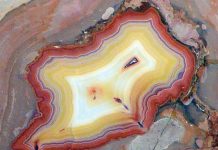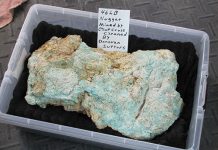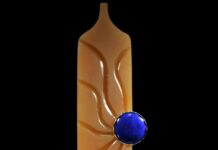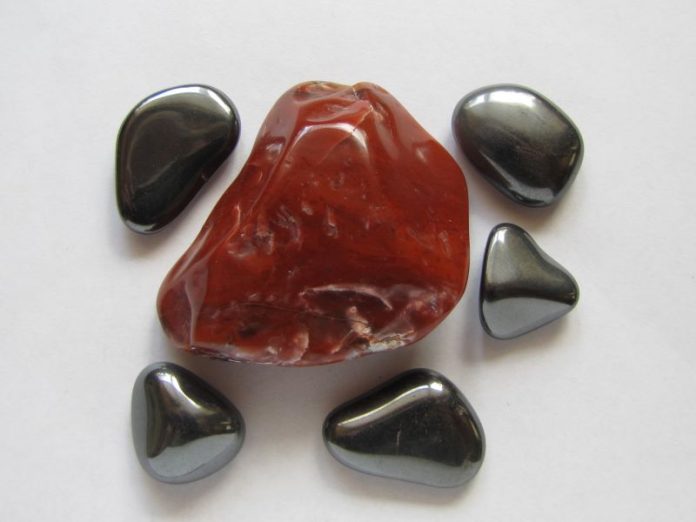
Hematite is the Earth’s greatest natural pigment, the primary ore of iron and a minor gemstone. It was also a key player in the Precambrian Great Oxygenation Event that made the Earth habitable. Hematite is mineralogically unique, having two forms that exhibit radically different colors. Sheer abundance and a mundane chemistry identical to that of iron rust give hematite a rather commonplace image, but it’s far from commonplace
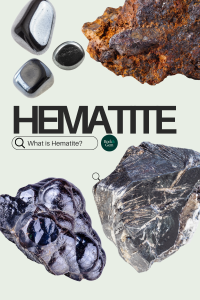
Hematite: The Mineral
Hematite, or iron oxide (ferric, Fe2O3) is one of the most common minerals in the Earth’s crust. Its iron content of 70 percent gives it a relatively high specific gravity of 5.3 and an authoritative heft in the hand.
It also has a substantial Mohs hardness of 5.5-6.5. Hematite crystallizes in the hexagonal (trigonal) system as tabular and rosette crystals but occurs mostly as particles in massive, earthy, granular, columnar, disseminated and stalactitic forms.
As a ubiquitous rock-forming mineral, hematite is a component of most igneous, metamorphic and sedimentary rocks. It varies greatly in appearance with colors ranging from red and reddish-brown to black and silvery-gray; its luster varies from dull to submetallic.
Hematite has two basic varieties: crystalline, which is black or nearly black; and particulate, which is red. These divergent colors led early mineralogists to believe they were entirely different minerals.
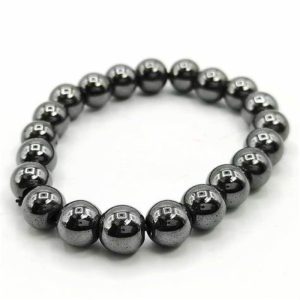
Courtesy Wikimedia Commons
Black Hematite
The black color of hematite’s macrocrystalline and botryoidal forms is caused by the light-reflectance properties of their opaque, crystalline surfaces, which absorb most incident white light equally across all wavelengths to reflect a color that we perceive as black. The limited degree of metallic bonding within hematite’s crystal lattice explains its submetallic luster.
Black hematite occurs as thick-to-thin tabs often arranged in parallel clusters or stacked in rosettes called “iron roses.” Botryoidal forms, known as “kidney ore,” have a glassy smoothness and a soft, submetallic luster. A micaceous form called specularite appears as shiny, parallel growths of tiny, mica-like flakes that reflect light with silvery glitter. Black hematite sometimes exhibits a subtle multicolored, iridescent patina.
As a minor gem material, black hematite is fashioned into figurines, cabochons, and beads and tumbled into free-form pieces. Hematite-bead necklaces were especially popular as mourning jewelry during Victorian times. Today, however, most “hematite” figurines and beads are imitations made of synthetic ceramic-ferrite materials that closely match natural hematite’s color, polish and heft. The highly magnetic “hematite” beads popular in novelty shops are artificially magnetized ferrite material (natural hematite is only very weakly magnetic).
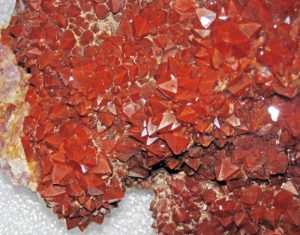
Courtesy Wikimedia Commons
Red Hematite
All forms of red hematite are particulate in structure rather than crystalline. Their random array of tiny, irregular particles absorbs the blue, green and yellow wavelengths of incident white light to reflect only the upper portion of the visible spectrum that we perceive as red. The name “hematite” derives from the Greek haimo- or “blood-like” and alludes to particulate hematite’s red color.
The color of red hematite varies greatly depending on particle size. Hematite particles less than 0.1 microns in size reflect orange, while those between 0.1 and 0.5 microns reflect a rich red. Particles as large as 1.5 microns appear purple. (One micron roughly equals the diameter of a thread in a spider’s web.) Particles larger than 1.5 microns take on the absorption-reflection characteristics of crystalline hematite and thus appear black.
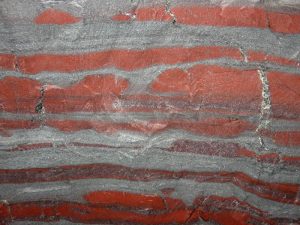
Courtesy Wikimedia Commons
The Great Red Pigment
With its red color and worldwide abundance, particulate hematite—which was obtained from surface deposits of ochre, a hematite-rich clay, was the first pigment used by man. Hematite pigments have been found in human burial sites more than 100,000 years old.
Ochre may be red, yellow or even purple depending on its hematite-particle size and mineral impurities. European Renaissance and post-Renaissance painters relied on refined, finely ground hematite as their standard red pigment. Red hematite pigments are still available commercially today.
Included hematite particles account for the red color of such gemstones as carnelian, red jasper and also the bright-red patterns in the green chalcedony matrix of bloodstone. In “red quartz,” a popular collectible, particles of hematite are included within, or encrusted on, otherwise colorless quartz crystals.
On a much grander scale, particulate hematite literally colors our world, imparting coloration to the celebrated red-rock canyons and mesas of Utah, and also to Georgia’s bright red clay. And particulate hematite is so abundant in the surface rocks and soil of Mars that it appears red in our night sky and is aptly nicknamed the “Red Planet.”

Courtesy Wikimedia Commons
The Great Oxygenation Event
Hematite was also one of the mineral products of the Great Oxygenation Event, a sweeping biochemical transition that began 2.5 billion years ago when the Earth’s acidic, iron-rich seas were unfit for life.
But the proliferation of simple, algae-like life forms called cyanobacteria released large quantities of oxygen to decrease seawater acidity and precipitate enormous quantities of iron as magnetite (ferric-ferrous oxide, Fe3O4) and silicon as chert (microcrystalline quartz, SiO2).
As these seafloor layers of magnetite and chert lithified, much magnetite altered into hematite. These ancient seafloor sediments are today’s massive deposits of banded iron ores which show layers of reddish chert colored by particulate hematite alternating with shiny gray layers of crystalline hematite.
More than 500 million tons of banded iron ores, primarily hematite, are now mined annually around the world.
So as an ore, a pigment and a gemstone, hematite is many things. But commonplace is not one of them.
This story previously appeared in Rock & Gem magazine. Click here to subscribe. Story by Steve Voynick.


